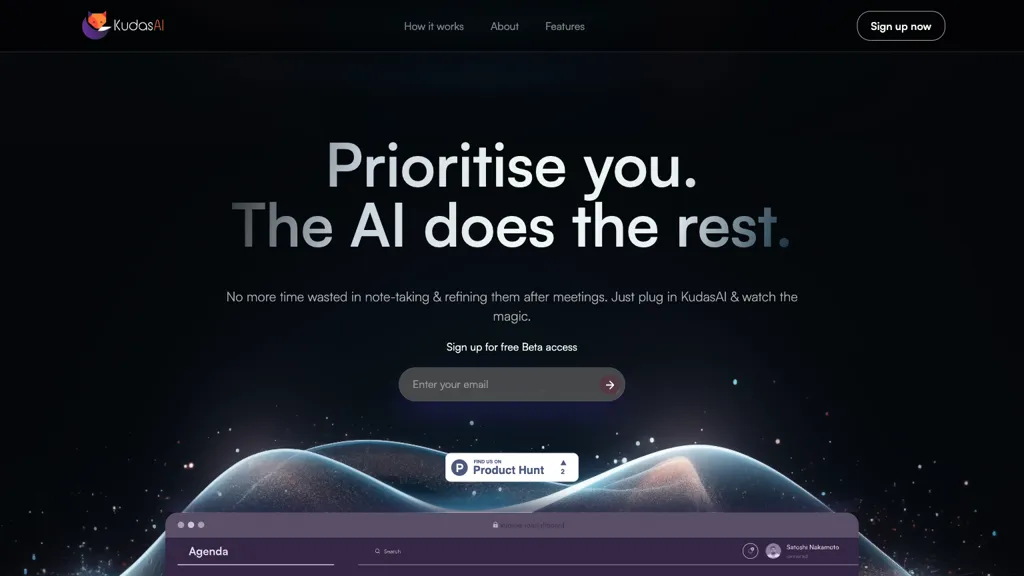What is KudasAI?
KudasAI is an AI-powered assistant that is designed with the aim of making agile meetings more productive. It automates jobs and streamlines these burdensome note-taking duties. KudasAI uses powerful GPT-4 technology to automate the drudgery of note-taking, orchestrates task assignment with ease, and enhances collaboration among teams through smart ticketing. This would free up 30-40% of team members’ time, which is otherwise wasted in unproductive activities like note-taking, and engage them more constructively towards teamwork. Therefore, it will raise the bar for overall engagement and productivity within the team. It easily integrates into the workflow of any team by simplifying task assignments, syncing communications, and summarizing discussions. Other features that make KudasAI an important and indispensable tool in optimizing team meetings include universal search, hybrid search algorithms, and agileflow task management.
Key Features & Benefits of KudasAI
Note-taking using GPT-4 technology.
Long and short-term ability to prioritize tasks in order of their importance.
Intelligent ticket creation to assist in teamwork.
Quite easy integrations into workflows of teams.
Search everywhere, hybrid algorithms.
The benefits that accrue through the use of KudasAI are many. For one, it saves a lot of time on manually taking notes. It is also good for prioritizing tasks because it prompts smart tickets and manages organized and effective meetings. Smooth onboarding into the workflow ensures the tool works in conjunction with existing systems to maximize productivity and improve team collaboration overall.
KudasAI Use Cases and Applications
KudasAI can be applied for the following cases to make agile meetings even more effective:
- Note-taking in agile meetings will be automated; hence, team members can spend more time on active participation instead of manual note transcription.
- Smart ticket generation for task prioritization will help make meetings well-organized, allowing for better orchestration and improving collaboration.
- Smooth out task assignment and syncing of communication through seamless workflow integrations, which enable the optimization of overall meeting efficiency and boost team productivity.
KudasAI can be useful in many industries and sectors such as project management, software development, business analysis, consulting, and remote teams. These include but are not limited to several user groups: Project Managers, Team Leads, Developers, Business Analysts, and Consultants who may leverage this platform to enhance workflow and teamwork.
How to Use KudasAI
Using KudasAI: as Easy as A-B-C
Herein is the step-by-step usage of KudasAI.
- Sign up for free beta access and get super early notifications when KudasAI releases its limited availability.
- Follow the provided steps in configuring KudasAI within the workflow.
- Have KudasAI automate Note Taking and Task Prioritization during meetings.
- Let the Smart Ticket Generation help in team collaboration and organization.
- Peruse Notes, Tasks, and Tickets using Universal Search and Hybrid Search Algorithms for efficient return of results.
Best Practice: All team members know the features and functionalities of KudasAI. Keep updating it regularly to get the latest features and improvements.
How KudasAI Works
Kudas AI works on deploying advanced GPT-4 technology in automating note-taking and task management processes. It deploys sophisticated algorithms in prioritizing tasks and generating smart tickets that promote effective team collaboration. In essence, the underlying workflow is all about smooth integration within the existing process of the team to ensure that responsibilities are well distributed and communication gets appropriately synced.
Moreover, it makes task and note management easier with its universal and hybrid search algorithms for faster retrieval of information. Overall, the technology at KudasAI manages agile meeting processes more productively and efficiently.
Pros and Cons of KudasAI
Pros of Using KudasAI:
- Time efficiency in saving hours with automated note-taking.
- Better prioritization and organization of tasks.
- Enhanced collaboration within teams; hence, it enhances productivity.
- It gets seamlessly integrated into workflows.
- Basically, one will get information faster because of the universal and hybrid search algorithms.
Possible negative features/ limitations:
- A small learning curve for the first-time user.
- Use of the tool for note-taking will lower personal note-taking capability.
User response and reviews state that Kudas AI works extremely well to organize Agile meetings in a seamless way and hence boost overall productivity for the teams. On the downside, users report the initial learning curve.
Conclusion about KudasAI
In all, KudasAI is a powerful AI assistant that seeks to upgrade agile meetings by way of automated note-taking, prioritization of tasks, and the generation of smart tickets. It easily fits into team workflows and contributes positively to productivity and effective collaboration within teams. Though it has a minor learning curve when one first uses it, the tool saves a lot of time and gives further organization; hence, it’s a good addition to any toolkit. Future enhancement and updates are likely to make it even more functional and friendly for its use.
KudasAI FAQs
Frequently asked questions about KudasAI:
-
What is KudasAI?
KudasAI is an AI-driven assistant in agile meetings, where the AI automatically keeps notes and follows up on tasks. -
How does KudasAI automate note-taking?
Using state-of-the-art GPT-4 technology, KudasAI auto-transcribes meeting notes, allowing team members to participate in the discussion instead of note taking. -
Who is the target user of KudasAI?
Project managers, team leads, developers, business analysts, consultants, and remote teams. -
Is the KudasAI platform easy to add into existing workflows?
Yes, KudasAI is seamlessly integrated into your team’s workflow for an effortless adaptation and usage process. -
What are the key features of KudasAI?
Key features include AI-assisted note-taking, task prioritization, smart ticket generation, universal search, and hybrid search algorithms.










